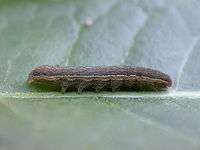Small square-spot
| Small square-spot | |
|---|---|
 | |
| Scientific classification | |
| Kingdom: | Animalia |
| Phylum: | Arthropoda |
| Class: | Insecta |
| Order: | Lepidoptera |
| Family: | Noctuidae |
| Genus: | Diarsia |
| Species: | D. rubi |
| Binomial name | |
| Diarsia rubi (Vieweg, 1790) | |
| Synonyms | |
| |
The small square-spot (Diarsia rubi) is a moth of the family Noctuidae. It is found in Europe apart from the far south-east then East through the Caucasus, Transcaucasia, Central Asia, Siberia , Russian Far East, Kamchatka.

Description
This is a quite a small species (wingspan 30–38 mm) with dull greyish pink forewings,varying to red brown, marked with a pale angular mark which gives the species its common name. Forewing with the cross lines and shades olive; the cell brown; reniform with whitish outline; claviform with a dark speck at its end; marginal area dark. The hindwings are pale luteous grey with a pink fringe.[1]
Biology
Two broods are produced each year with the adults flying in May and June and again in August and September.[2] Moths of the second brood are usually smaller and darker than those of the first. The species flies at night and is attracted to light and sugar. It will also visit flowers such as heather and ragwort.
The larva feeds on a variety of plants: recorded food plants include raspberry, Vaccinium and willow.[3] The species overwinters as a larva.
References
- ↑ Seitz, A. Ed., 1914 Die Großschmetterlinge der Erde, Verlag Alfred Kernen, Stuttgart Band 3: Abt. 1, Die Großschmetterlinge des palaearktischen Faunengebietes, Die palaearktischen eulenartigen Nachtfalter, 1914
- ↑ The flight season refers to the British Isles. This may vary in other parts of the range.
- ↑ "Robinson, G. S., P. R. Ackery, I. J. Kitching, G. W. Beccaloni & L. M. Hernández, 2010. HOSTS - A Database of the World's Lepidopteran Hostplants. Natural History Museum, London.".
- Chinery, Michael Collins Guide to the Insects of Britain and Western Europe 1986 (Reprinted 1991)
- Skinner, Bernard Colour Identification Guide to Moths of the British Isles 1984
External links
| Wikimedia Commons has media related to Diarsia rubi. |
- Small square-spot up UKmoths
- Small square-spot at Markku Savela's Lepidoptera pages (Funet)
- Lepiforum.de